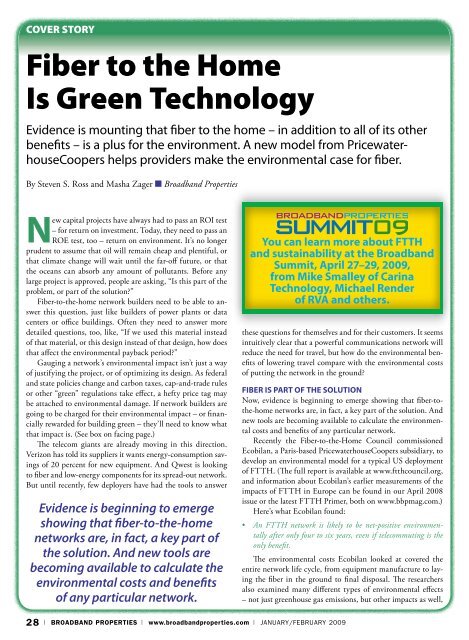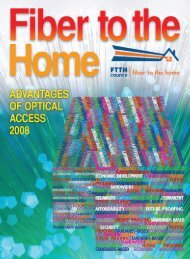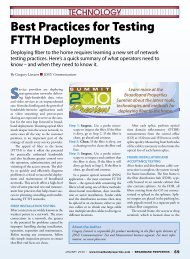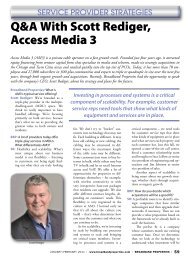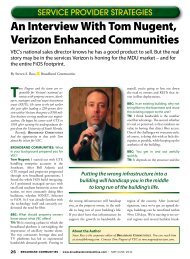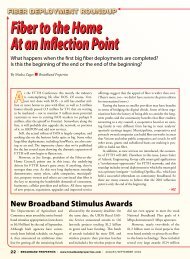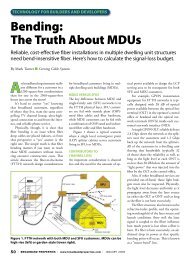bbpmag.com - Broadband Properties
bbpmag.com - Broadband Properties
bbpmag.com - Broadband Properties
Create successful ePaper yourself
Turn your PDF publications into a flip-book with our unique Google optimized e-Paper software.
Cover Story<br />
Fiber to the Home<br />
Is Green Technology<br />
Evidence is mounting that fiber to the home – in addition to all of its other<br />
benefits – is a plus for the environment. A new model from PricewaterhouseCoopers<br />
helps providers make the environmental case for fiber.<br />
By Steven S. Ross and Masha Zager ■ <strong>Broadband</strong> <strong>Properties</strong><br />
New capital projects have always had to pass an ROI test<br />
– for return on investment. Today, they need to pass an<br />
ROE test, too – return on environment. It’s no longer<br />
prudent to assume that oil will remain cheap and plentiful, or<br />
that climate change will wait until the far-off future, or that<br />
the oceans can absorb any amount of pollutants. Before any<br />
large project is approved, people are asking, “Is this part of the<br />
problem, or part of the solution”<br />
Fiber-to-the-home network builders need to be able to answer<br />
this question, just like builders of power plants or data<br />
centers or office buildings. Often they need to answer more<br />
detailed questions, too, like, “If we used this material instead<br />
of that material, or this design instead of that design, how does<br />
that affect the environmental payback period”<br />
Gauging a network’s environmental impact isn’t just a way<br />
of justifying the project, or of optimizing its design. As federal<br />
and state policies change and carbon taxes, cap-and-trade rules<br />
or other “green” regulations take effect, a hefty price tag may<br />
be attached to environmental damage. If network builders are<br />
going to be charged for their environmental impact – or financially<br />
rewarded for building green – they’ll need to know what<br />
that impact is. (See box on facing page.)<br />
The tele<strong>com</strong> giants are already moving in this direction.<br />
Verizon has told its suppliers it wants energy-consumption savings<br />
of 20 percent for new equipment. And Qwest is looking<br />
to fiber and low-energy <strong>com</strong>ponents for its spread-out network.<br />
But until recently, few deployers have had the tools to answer<br />
Evidence is beginning to emerge<br />
showing that fiber-to-the-home<br />
networks are, in fact, a key part of<br />
the solution. And new tools are<br />
be<strong>com</strong>ing available to calculate the<br />
environmental costs and benefits<br />
of any particular network.<br />
You can learn more about FTTH<br />
and sustainability at the <strong>Broadband</strong><br />
Summit, April 27–29, 2009,<br />
from Mike Smalley of Carina<br />
Technology, Michael Render<br />
of RVA and others.<br />
these questions for themselves and for their customers. It seems<br />
intuitively clear that a powerful <strong>com</strong>munications network will<br />
reduce the need for travel, but how do the environmental benefits<br />
of lowering travel <strong>com</strong>pare with the environmental costs<br />
of putting the network in the ground<br />
Fiber Is Part of the Solution<br />
Now, evidence is beginning to emerge showing that fiber-tothe-home<br />
networks are, in fact, a key part of the solution. And<br />
new tools are be<strong>com</strong>ing available to calculate the environmental<br />
costs and benefits of any particular network.<br />
Recently the Fiber-to-the-Home Council <strong>com</strong>missioned<br />
Ecobilan, a Paris-based PricewaterhouseCoopers subsidiary, to<br />
develop an environmental model for a typical US deployment<br />
of FTTH. (The full report is available at www.ftthcouncil.org,<br />
and information about Ecobilan’s earlier measurements of the<br />
impacts of FTTH in Europe can be found in our April 2008<br />
issue or the latest FTTH Primer, both on www.<strong>bbpmag</strong>.<strong>com</strong>.)<br />
Here’s what Ecobilan found:<br />
• An FTTH network is likely to be net-positive environmentally<br />
after only four to six years, even if tele<strong>com</strong>muting is the<br />
only benefit.<br />
The environmental costs Ecobilan looked at covered the<br />
entire network life cycle, from equipment manufacture to laying<br />
the fiber in the ground to final disposal. The researchers<br />
also examined many different types of environmental effects<br />
– not just greenhouse gas emissions, but other impacts as well,<br />
28 | BROADBAND PROPERTIES | www.broadbandproperties.<strong>com</strong> | January/February 2009


